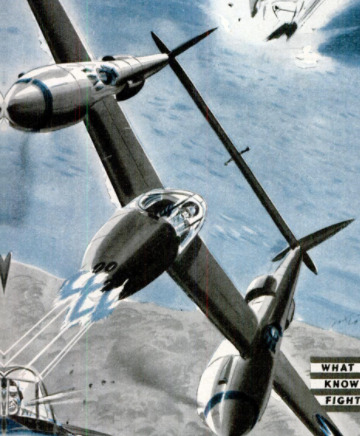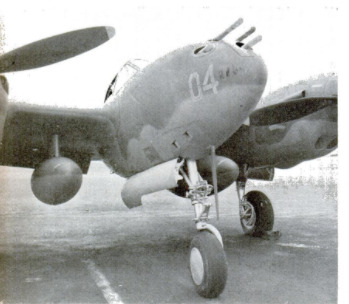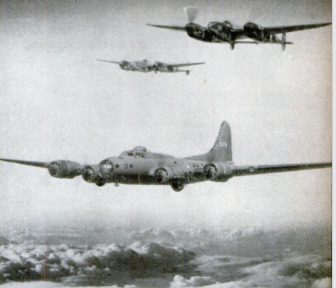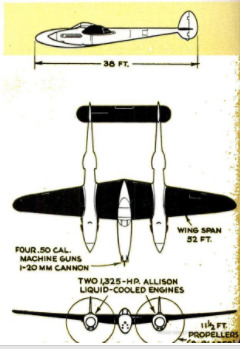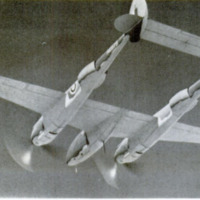-
Title (Dublin Core)
-
The new P-38 "Lockheed Lightning"
-
Article Title and/or Image Caption (Dublin Core)
-
Title: German pilots renamed it "Gabelschwanz Teufel" (fork-tailed devil)
-
extracted text (Extract Text)
-
THE U.S. Army prosaically called its
new fighter-interceptor “P-38." Lock-
heed Aircraft engineers and test pilots
called it “Lightning,” and that name
stuck with the combat pilots who flew it.
And now the Germans have a word of
their own for this twin-engine, twin-
boom aerial destroyer. Nazi pilots shot
down and captured in recent operations
bitterly referred to it as that “Gabel-
schwanz-teufel!”—fork-tailed devil!
But under any name at all, it's a lot of
combat airplane—one of the fastest,
highest-flying, hardest-hitting ships ever
turned out. For all-around versatility
and power the P-38 is in a class by
itself. It has been used successfully as
a fighter, interceptor, bomber escort,
bomb carrier, low-level strafer and tank-
buster, long-distance reconnaissance ship,
and high-altitude photographic plane.
Performance on most of the major bat-
tle fronts has shown the Lightning to be
equally effective flying from hastily
carved-out jungle fields in the far Pacific,
from cramped and rocky fields in the
Aleutian Islands, from the sandy wastes
of North Africa, and from the mist-bound
runways of England. One of its most im-
portant services was to make possible
American daylight bombing raids over
Germany. The Lightnings provided fight-
er escort at high altitude hundreds of
miles from the home bases, fending off
enemy attacks over the target area for as
much as an hour, then accompanying the
bombers on the dangerous return
flight and seeing them in to a safe
landing.
P-38's didn't swing into action as
soon as the United States was plunged
into the war. Our enemies unques-
tionably knew that we had a ship of
this unconventional design in the
works, but they couldn't know much
about its performance and fighting
characteristics. Wise military strate-
gy in a case like that dictates that
the new weapon be withheld from
action until it can be assembled at
the proper places in quantities large
enough to take maximum advantage
of its surprise punch.
Squadrons of Lightnings were
organized first in the Pacific area,
then others were sent to England,
and finally the plane emerged in
North Africa as our main fighter
type for that theater. The ship has
been a thumping success in all three
theaters of war.
Probably the first official combat
involving P-38's was in the Aleutians,
when the fork-tailed ships suddenly
popped out of a cloud and shot down
two Japanese K-97 four-engined fly-
ing boats and two escort fighters.
Even more significant than the vic-
tory itself was the fact that this
combat dispelled a notion that the
Lightning was a high-altitude ship,
unable to perform at lower levels.
There isn’t any high altitude to speak
of in the fog-shrouded Aleutians.
Even more spectacular in result
was the Lightnings’ first battle with
the Japanese in New Guinea. Twelve,
of the P-38’s ran into a much larger
enemy group, including some seven
“Val” dive bombers and an escort of
25 or 30 fighter planes—‘Zekes,”
‘““Haps,” and “Oscars.” (Zeke and Hap are
the two current versions of the well-publi-
cized Jap Zero fighter; Oscar is another
fighter plane, the Nakajima 97.) The Light-
ning pilots shot down 15 enemy craft and
damaged several others which probably
didn’t get back to their bases. None of our
pilots were injured and only one of the
planes was damaged.
The P-38 had another brilliant debut in
North Africa, one squadron destroying 15
enemy planes in the first day's operations
over the Gabés-Sfax area of Tunisia. Later
the planes went on important ground-straf-
ing missions and knocked out 11 tanks in
two days, along with much enemy transport,
including trucks, armored cars, and motor-
cycles.
The Lightning has fought it out there on
even terms with the very hottest enemy fight-
er planes, among them the German Messer-
schmitt 109, 110, and 210, and the Focke-
‘Wulf 190. American
pilots swear by their
ship, and vow it is
the best pursuit job
in action there.
This actual battle
experience has
served to dispel some
of the doubts airmen
and Army men felt
about the P-38 de-
sign when it first
became known. To
sum these doubts up:
Wasn't it too big—
“just too much air-
plane for one man?”
Wouldn't it lack fight-
er-plane maneuver-
ability? Would that
open-work twin-boom
construction have the
strength to stand up
and take the punish-
ment of military oper-
ations? And wouldn't
that same construc-
tion make it impossi-
ble for a pilot to get
out safely in a para-
chute if the occasion
arose?
The answers have
come along fast under
war conditions. The
P-38 is beyond any
doubt a first-class one-
man fighter ship. As
for its maneuverabili-
ty, some of the Amer-
ican pilots in North
Africa were so en-
thusiastic they told correspondents they
could turn inside a Spitfire. Their testi-
mony naturally must be taken with at least
a grain or two of salt; other factors being
approximately equal, the smaller and lighter
airplane always should have greater ma-
neuverability than the larger and heavier
one. And the huskiness, power, and long
range built into the Lightning must have
required some slight sacrifice of other
characteristics, Nevertheless, the battle
performance of this P-38 against Germany's
best ships is proof that it has maneuver-
ability enough to play in the big league of
air warfare.
The question of parachuting from the
ship was tricky, but it has turned out that
the trick can be done. A pilot can bail out
either by flipping the ship over on its back
and dropping from the open hatch, or by
putting it into a stall and stepping back
and down nto the space back of the cockpit
and between the twin booms. This may
sound complicated, but it is not a simple op-
eration to bail out of any hot ship, and the
baller always must follow a prescribed tech-
nique to avoid the fast-moving tail and
elevator surfaces.
There remained the question of the ship's
strength, and a big part of that was whether
the twin-motor arrangement wasn't a real
weakness—just two things to get hit or go
wrong. The growing list of Lightnings that
have come in all right on one engine has
set that point at rest; in fact, the climbing
powers of the ship with an engine out of
action have been a delightful surprise to
more than one hard-pressed pilot.
As for the structural strength of the plane,
startling proofs of that came in recently
from battle areas half the world apart. Over
New Guinea Lieut, Kenneth C. Sparks, of
Blackwell, Okla, got into a tight dogfight
with a Zero, and here is what he reported:
“Our right wing-tips hit, spinning the
Zero around so that its propeller struck the
trailing edge of my wing. He went down
smoking and I kept on going.”
Lieutenant Sparks admitted it was a
tough jolt, but he was unhurt and his plane
showed no damage except for a slight
chewing up of that wing.
Around the same time, a group of Light-
nings went out on a strafe in Tunisia, and
pressed their attack home on one enemy air-
field at such a low altitude that one of the
ships knocked over a telephone pole. Capt.
Mark Morne, of Hinsdale, IIL, in charge of
the operation, reported laconically:
“Fortunately the accident only dented a
wing of the piane, and he returned safely.”
Airplane designers don't advise using their
ships for disrupting enemy communications
in quite such a direct manner, but it doesn't
hurt pilot morale to know that you can get
away with it if the occasion should arise.
Nothing very much like the P-38 had been
tried out up until 1937, when the Army
called in the nation's plane makers to
study specifications for a new fighter aimed
primarily to intercept any air raiders that
might approach our coasts. Speed, range,
and fire power were the prime requisites.
The Lockheed company didn't have much
military background, but Hall Hibbard,
chief engineer, and C. L. Johnson, chief of
design, thought they might have the answer
in their private notebooks.
From the beginning they planned on a
twin-boom, twin-engine ship. Twin engines
would give added power and added safety,
in case one power plant failed, plus better
vision for the pilot and a chance to incor-
porate heavy gunpower in the nose without
getting into the technical problem of syn-
chronizing the guns to fire through a
propeller arc.
Twin booms promised excellent control
plus improved streamlining—a notion which
worked out so well, by the way, that the
present model, with its tricycle landing gear
retracted, presents no greater drag than a
card table 27 inches square.
The first ship began its flight-testing on
December 30, 1939, and a few days later
made a hop from California to New York
in which it loafed along at never better than
two-thirds throttle, made two stops for fuel,
and completed the run in seven hours, 45
minutes.
Minor changes in design were effected,
and improvements suggested by actual use
incorporated. It was not until September
1940 that the first actual production model
rolled off the line. Some airmen, pointing
out that the ship was heavier than a 10-
passenger commercial transport plane, still
thought it was a freak, with no real future
as a fighter. The Army knew better, but
took the wise decision to keep its husky
baby under wraps until it had enough of
them to deliver a solid punch.
The combination of power, clean aero-
dynamic design, and a quick-acting combat
flap enables the P-38 to fly great distances
and then battle on even terms with enemy
interceptors hundreds of miles from its own
base. The ship can take off and land at 80
miles per hour, fly faster than 400 m.ph.,
climb to 40,000 feet, carry up to two tons
of bombs for short distances, and outrun the
speediest enemy if that becomes necessary.
That combat flap, developed when the
Army called for increased maneuverability,
increases the wings’ lift substantially while
increasing the drag only slightly. Thus the
P-38 can roar to its objective at top speed,
and in three seconds the pilot can lower the
flaps to transform his ship into an acrobatic
dogfighter, dive bomber, ground strafer, or
precision bomber. After raising the flaps—
time, four seconds—he can streak for home,
then lower them again to land safely in
snow, soft earth, or a rough field.
Although a heavy fighter, the Lightning
apparently can be maneuvered in a fairly
short radius, and has shown a surprising
ability to climb on one engine even in
combat with the vaunted lightweight Zero.
Its propellers, driven by 1,325-hp. Allison
engines, rotate in opposite directions, nullify
ing the torque and giving it equal maneuver-
ability to either side. Pilots have taken
advantage of that to blast many a Jap or
Nazi flyer who could pull out of a dive only
to the right because of torque. |
Its high speed and altitude have made
the Lightning invaluable upon occasion as
a photographic reconnaissance ship. Stripped |
of armament, it can snap and run away in
broad daylight. Painted dead black for night
work, it can get into position for the run, |
pop flares, snap its pictures, and glide off |
like a dark cloud before the wind. |
In thie connection, it is an odd fact that
the Lightning's first shooting encounter with
the enemy occurred while the ship was un-
armed. Capt. Karl Polifka was taking |
pictures over Lae and Rabaul, New Guinea,
when a flight of Zeros jumped him and
knocked out his port engine in the first
burst. Unable to fight back, Capt. Polifka
climbed to 25,000 feet on the remaining
engine, evaded the foe, and got home with
photos which were officially credited with
helping to win the Battle of the Coral Sea.
As fighters go, the P-38 is a big ship and
a strong one. It can take a lot of gunfire
punishment without crumpling, for its wings
are double-skinned and its strength mem-
bers double-stressed. If a wing is riddled,
the spars can support the ship's weight; if a
spar is severed, the skin itself has structural
strength to hold together for the homeward
flight.
No other fighter surpasses the P-38 in
sustained fire power. It has various combi-
nations of armament, a typical arrange-
ment being four .50 caliber machine guns®
and a 20-millimeter automatic cannon, all
concentrated in the nose, whence they can
deliver an intense slash of steel and ex-
plosive. The pilot also can do a lot of
shooting without a reload; the Lightning
normally carries some five times the weight
of guns and ammunition packed by lighter
ships such as the Zero.
Most recent additions to the Lightning's
equipment are combinations of extra gas
tanks, smoke tanks, and bombs. The stream-
lined, droppable fuel tank of 150-gallon
capacity enables the ship to protect bombers
over a combat range of 750 miles and farth-
er. Over shorter ranges, P-38's have carried
as much as two tons of extra equipment,
including medium-size bombs.
Extra range also has made the P-38 a
handy ship for delivery to the war zones.
Lightnings flown to the Aleutians gave the
Japs a rude surprise early in the war. Hun-
dreds of them have made mass flights across
the North and South Atlantic. For such
hops, each plane carries two extra 165-
gallon fuel tanks, one under each wing. When
the gasoline is used, the tanks are jettisoned.
Since P-38 pilots have no time or equipment
for navigation, a Flying Fortress accom-
panies each flight as “shepherd.”
The P-38 is getting around in this war,
and you may see it anywhere. If so, it will
be an easy ship to spot from the ground—
partly because of the forked tail that im-
pressed the Germans so forcefully, and
partly because of the front arrangement of
wing, nose, and two engines, which gave it
the airmen’s poetic description of “three
bullets on the edge of a sword.”
-
Contributor (Dublin Core)
-
Andrew R. Boone (Article Writer)
-
Language (Dublin Core)
-
eng
-
Date Issued (Dublin Core)
-
1943-09
-
pages (Bibliographic Ontology)
-
96-100, 206, 208
-
Rights (Dublin Core)
-
Public Domain (Google Digitized)
-
Archived by (Dublin Core)
-
Matteo Ridolfi
-
Marco Bortolami (editor)
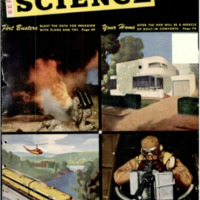 Popular Science Monthly, v. 143, n. 3, 1943
Popular Science Monthly, v. 143, n. 3, 1943

